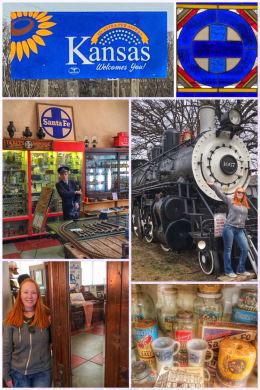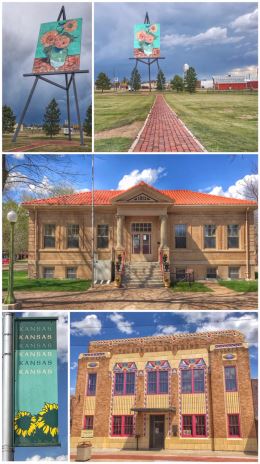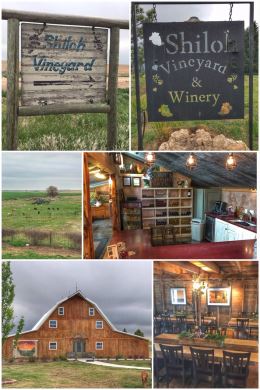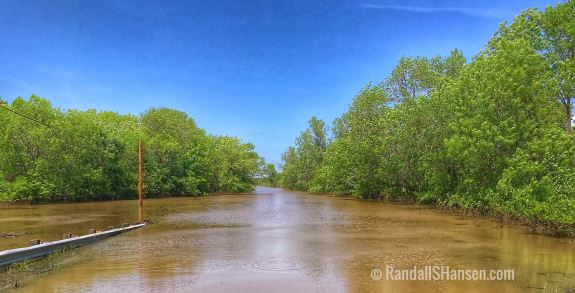
We spent about two weeks driving through Kansas — the Sunflower State — and of those two weeks, we had about two days without rain! Most of the time, it was cool and rainy, though toward the end it was hot and muggy. We are seeing crazy (and wet) weather patterns as we travel.
We actually started our adventures into Kansas a few weeks back when we were traveling through Oklahoma on our way to Colorado… not finding any decent RV parks on that route, we made a quick diversion up into Wellington, Kansas, originally named for the Duke of Wellington, and a formerly big railroad town… it even had one of the famous Santa Fe Depots and Harvey Houses, until demolished in the 1960s after being vacant for decades. Luckily, when we visited, the flooding had not hit the region. We stayed at the KOA, northeast of town, a nice little campground — and which is within walking distance of a Walmart Supercenter.
The main draw for us in Wellington was the Panhandle Railroad Museum, an amazingly comprehensive private collection curated over many decades by former train conductor Perry Wiley; we did not meet him that day, but his wife Sherry gave us the grand tour. The memorabilia includes train lanterns, locks, bells, whistles, china, and more. What fascinated Ran (the marketer) was all the branded Santa Fe items, including salt, coffee, flour, mayo, jelly, peanut butter, catsup, and furniture polish. While the Wileys do not own the building, it too is cool — a stone building that was a coal gasification plant from 1886-1906. An old Atchison, Topeka & Santa Fe Railway locomotive sits across from the museum.

While in Wellington, we had to also have our first taste of Kansas wine… so we traveled about 16 miles north to Wyldewood Cellars Winery, a family-owned vineyard and winery located in Peck. (The winery is about 20 miles south of Wichita, where we had also visited — including a stop at one of our now-favorite grocery stores, Natural Grocers, which sells 100-percent organic and GMO-free produce, pasture-based dairy, and antibiotic and hormone-free meats.) We enjoyed the tasting, and left with a bottle of Cabernet Sauvignon Reserve.
For those interested in other attractions in Wellington, check out the Chisholm Trail Museum, housed in a former hospital building constructed in 1916; and the 674-acre Wellington Lake, which offers camping, picnic areas, and boat ramps.

Next up was a trip across Kansas, starting in Goodland… a town perhaps best known for having a giant (80-feet high) replica of Vincent Van Gogh’s 3 Sunflowers in a Vase as a roadside attraction. The town developed, as many towns did back then, as a railroad town, with a depot for the Chicago, Rock Island and Pacific Railroad. Today, it’s a pretty quiet town, but certainly one worthy of at least an overnight visit.
We enjoyed a visit to the High Plains Museum — an easy walk from the Goodland KOA, another very nice and quiet campground. The museum is a local history repository owned and operated by the city; it feature a collection of more than 8,000 objects that represent more than one hundred years of Northwestern Kansas history.
We also had a fun bike ride through many of the residential streets of the town, enjoying the sights and sounds of small town life… with one exception: Jenny somehow hit a nail directly with her bike and her back tire went flat almost immediately. We went to the Walmart and replaced the tube; we also contacted the city about sweeping their streets, but never heard back. What’s up Goodland?

Next up, as we moved eastward through Kansas, was WaKeeney, founded in 1879 and the so-called “Queen City of the High Plains” … and more recently, “The Christmas City of the High Plains” (because the city strings more than 6,000 lights on a 35-foot tall handmade Christmas tree). We had planned to stay just two nights, but flooding in Salina, our intended next stop had us hanging around for four days… so, we made do, starting with a visit to a rare prairie winery.
Shiloh Vineyard & Winery, a small family-owned winery founded in 2008 by Kirk and Treva Johnston. The winery is absolutely beautiful, including an old barn that has been converted into a special events room; the tasting room is in a converted chicken house. Shiloh offers a variety of reds, whites, and fruit wines. Some of the wines come from their own grapes, but most of the grapes and fruits are brought in from other orchards and vineyards from around the area. We bought bottle of the Norton, a full-bodied red with some nice berry flavors… unfortunately, when we opened the bottle a few days later, it had gone bad. Kirk offered to refund us the price of the bottle — which is great customer service — and so we look forward to using that to support another winery along our travels.

On one of the rare cloudy but not rainy days, we took a drive along the Smoky Valley Scenic Byway to a nearby state park: Cedar Bluff State Park, located on the bluffs of the 6,800-acre Cedar Bluff Reservoir, and located about 22 miles southeast of WaKeeney. We spent our time exploring the 500-acre Page Creek Area, located on the south side of the reservoir. (Another section, the 200-acre Bluffton Area, is more popular and located on the northeast side of the reservoir.) The park’s name comes from the Eastern Red Cedar trees; fun fact, some people thought the park was misnamed because the trees are junipers — and while the red cedar is part of the juniper family, they are indeed their own species, and native to nearby Missouri. We loved exploring this park, as it was completely empty (and even a bit spooky, with ramps leading to nowhere)… hiking the 1-mile (loop) Agave Trail, which is so-named because Agave is the family name for the Great Plains Yucca — found in abundance in the area. One can also add about 4 miles of hiking by adding the primitive Agave Ridge Nature Trail, which winds through a mixed grass prairie and includes a scenic bluff overlook.

As our time extended in WaKeeney, we took time to also visit Hays, about 34 miles east, an early railroad town and named after Fort Hays, a U.S. Army military post (which was named to honor General Alexander Hays, killed in the Civil War). Hays was home to several well-known figures of the Old West, including Calamity Jane and Buffalo Bill Cody; Wild Bill Hickok even served briefly as sheriff in 1869; a statue of his likeness stands downtown. We spent most of our time hiking in nature — first at Frontier Park (which includes a small herd of bison) and later at the Dr. Howard Reynolds Nature Trails (located adjacent to the Sternberg Museum of Natural History).
Happily, the rains let up just a bit and we were able to continue our travels eastward… with a few adjustments.
With the campground in Salina still under water, we changed plans and decided to camp a little farther east in Abilene, the hometown of the 34th President of the United States, Dwight D Eisenhower, and named from a passage in the Bible: Luke 3:1… meaning “city of the plains.” Wild Bill Hickok was also the law in Abilene for a short time in 1871.

We loved the look and feel of Abilene, and spent each day walking around the town. The town has two famous mansions. The Lebold Mansion, shown in the collage, was constructed in 1880 with native Kansas limestone by banker Conrad Lebold. Sadly, it has never been good luck for its owners and has been sold and used for many purposes (including as an orphanage and an apartment building) before finally being restored back to a private residence; it currently has new owners yet again as the most recent folks lost the house in an auction. The Seelye Mansion, built for Dr. A. B. Seelye of the A. B. Seelye Medical Company, is listed as one of the 8 Wonders of Kansas Architecture, and is furnished with items bought from the 1904 St. Louis World’s Fair; it also houses a wooden bowling alley that is more than 120 years old. Frank Lloyd Wright remodeled the interior of the mansion in the 1920s.

But the main attraction in Abilene is Ike and the Eisenhower Presidential Library, Museum, and Boyhood Home complex. Admission to the Visitor Center, Place of Meditation, and the archives is free, but it costs $12 for adults to visit the museum (which also includes a tour of the Boyhood Home).
We started at the visitor center and enjoyed watching a movie about the life and career of President Eisenhower, from young boy in Abilene to World War II hero to
president of Columbia University. He also served as the first Supreme Commander of NATO before being drafted by the Republican Party to run for president. He was president from 1953-1961. After the movie, we walked the grounds, which are beautiful, and include a statue of Eisenhower, Five Pylons (with inscriptions), his childhood home, the museum, archives, and a chapel — known as The Place of Meditation and which is the final resting place of the President Eisenhower, the First Lady, and their first-born son, Doud Eisenhower (who died of scarlet fever as a child).

The highlight of Abilene, though, had to be the Abilene and Smoky Valley Railroad, an non-profit organization formed in 1993 that offers cool heritage train rides from May through October. Typically, the train travels from Abilene to Enterprise, but on the day we took the train the flood level of the Smoky Hill River was so high, they decided not to take the train over the bridge for safety reasons.
Besides weekend train rides, the organization does chartered rides and dinner rides… all departing from the historic 1887 Rock Island Depot… and the rail line is part of a stretch of the Chicago, Rock Island and Pacific Railroad line that ran from Herington to Salina.
We decided to splurge on this train experience by upgrading to riding in the caboose one way and in the engine on the way back. It was our first time riding in either of these key elements of trains… we learned more about the use of the caboose and loved watching the engineer run the train from the engine.
All the trains are live-narrated… and all the people who work the trains are volunteers… which makes for a wonderful experience.

Our train consisted of a 1945 ALCO S-1 Engine (from the Hutchinson & Northern Railroad), equipped with a 660hp diesel-electric engine that was originally designed for WWII submarines; a 1902 wooden KATY passenger car that has been converted to a dining car; two open air gondola cars with canopy top; and a former Union Pacific caboose.
During our travels on the train, all the personnel talked with us about the flooding — and the many months of rain — not seen for decades… or ever. We have now seen flooding in several of the states we have visited in 2019 — including Mississippi, Arkansas, Missouri, and now Kansas.
We ended our tour of Kansas with campground stay in Lyndon, with visits to Lawrence and Topeka. The drive down to Lyndon from Abilene was quite beautiful — as we drove through the Flint Hills, one of the last remaining tallgrass prairie ecosystems in the world. Amazingly, like so many other places we have visited in our travels, this area was once covered by a vast inland sea that deposited great layers of limestone, shale, and flint; the Flints Hills were created as the softer shale layers eroded away, leaving behind hardened flint shelves.

Ran chose the campground in Lyndon mainly for its location in eastern Kansas, but also because it is adjacent to the Flint Hills Nature Trail — a 117-mile rail-trail that crosses east-central Kansas, from Herington in the west to Osawatomie in the east. It is the seventh-longest rail-trail in the U.S., and the longest trail in Kansas. The trail sits on the rail corridor originally developed in the late 1880s by the Council Grove, Osage City & Ottawa Railway; it later became part of the Missouri Pacific Railroad; it was abandoned in the 1980s and railbanked in the 1990s; and is still being developed as a trail.
The trail follows the general route of the Santa Fe National Historic Trail and forms a component of the American Discovery Trail, the first coast-to-coast non-motorized trail, cutting across the middle of the United States… from Cape Henlopen State Park, Delaware, to Point Reyes National Seashore, California. (Amazingly for hikers and bikers, the Rails-to-Trails group is working on a second coast-to-coast trail, The Great American Rail-Trail, connecting rail-trails all across the country. How lucky are we?)

Next up was connecting with a local rancher who raises pastured, grass-fed and grass-finished sheep and cattle. Farmer Debbie of Homespun Hill Farm (located in Baldwin City, about 18 miles south of Lawrence) does an amazing job, and we got to visit with her and some amazingly sweet South Poll heifer calves. (South Poll cattle are known for their low-key docility temperament, making them a truly enjoyable animal to love and an easier breed for ranchers.) True grass-everything beef raised in a small farm environment is simply the best meat you can eat — and a million times healthier than the feedlot, grain-fed beef you find in most grocery stores. (Learn more about the benefits of grass-fed beef here.) As you can see in the pictures, Debbie also has a flock of geese (and chickens) roaming around the farm. We had hoped to buy (and try for the first time) some goat meat, but Debbie did not have any in inventory… so, instead, we left with some lamb loin chops, Kansas strip steaks, and beef tenderloins.
How can you find a local rancher with grass-fed meats? You can simply Google it, or better, use the EatWild website, where you can search for ranchers and farmers doing it right — including those with eggs, meats, fruits, and vegetables.

After sadly leaving Debbie and those sweet calves, we headed to Lawrence to do some hiking — to take advantage of one of our rare sunny days in Kansas!
We started in Clinton Lake State Park, just west of Lawrence, is a 1,500-acre park that has multiple facilitates for hiking, biking, camping, and boating. We hiked part of the 25-mile North Shore Trail until it became untenable because the trail became a muddy mess. We then tried to see other parts of the park — including the lake — but were thwarted as chunks of the park were closed because of high water levels from all the rains. We then headed over to the KANZA Southwind Nature Preserve, an 18-acre prairie park that has a pond and trails and offers a chance for seeing waterfowl. Its name comes from the Native American tribe that used to live on these lands — the KANZA, who were also known as “the People of the Southwind.”

We also cerebrated Ran’s birthday in Kansas, spending the day in the Topeka area, first visiting Lake Shawnee.
The lake started its life as a Work Progress Administration project completed in the 1930s and has become an amazing recreational facility — even named by Expedia in 2017 as the Best Place to Visit in Kansas. We parked at the Ted Ensley Gardens and loved all the blooming flowers in that section of the park. We even saw bunnies and baby ducks in that area. We then got to hiking the lake loop trail, a wide concrete trail that encircles the lake. We started hiking the trail and then decided to jump on two Topeka Metro Bikes, which you can rent in two spots along the lake (as well as many other spots within Topeka). We ended up hiking about 5 miles and biking about 2.5 miles. Besides the trail, you can find camping, golfing, boating, fishing, picnicking, and more.

The day took a more serious turn as we decided to visit the Brown vs. Board of Education National Historic Site, which commemorates the U.S. Supreme Court decision that ended racial segregation in U.S. public schools. The historic site is located in the Monroe Elementary School, which was one of four segregated elementary schools for African American children in Topeka.
The landmark case (officially the Oliver L. Brown et al v. Board of Education et al) resulted in a unanimous opinion of the court, stating: “We conclude in the field of public education the doctrine of ‘separate but equal’ has no place. Separate educational facilities are inherently unequal.” (Chief Justice Earl Warren, May 17, 1954)
A year later, the Supreme Court ordered that integration be implemented with “all deliberate speed” in an attempt to push some states into following the Court’s ruling.
Fun Fact: Five lawsuits from across the country were consolidated into the one case before the Supreme Court; four of the cases were from states along the east coast, but interestingly consolidated with the Topeka, Kansas, case.
We unfortunately arrived the week of the 65th anniversary of the decision, which meant lots of happenings and visitors to the site — and no chance to watch the movie. We did get to walk around the school and review some of the amazing exhibits about the struggle for civil rights.
A colorful and thought-provoking mural — the Brown v. Board Mural — is painted on a building adjacent to the historic site. “The mural explores themes of equality and justice through the eyes of young people in our community. Artist Michael Toombs directed the painting of the 130′ x 30′ wall along with a team of artists and thousands of members of the community. “

We spent our last day in eastern Kansas examining the flooding at Carbolyn State Park, located along Dragoon Creek, about 5 miles north of Lyndon. The park is part of the larger Pomona Lake area. The lake — a 4,000-acre reservoir — itself has risen so much that the state has closed roads and boat ramps.
As you can see from the pictures, the flooding from all the rains has surrounded the park and campground.
As we make a quick stop back in Nebraska before spending a few weeks in Iowa, we worry about the rains, the rivers and creeks backing up, and the flooding to the farms and properties of so many people.
We’ve been very grateful to finally see green leaves and blooming flowers, but the rainy, stormy, and windy weather is getting a bit tiresome. And our last few days in Kansas went from cold and wet and hot and humid, making some folks comment that we went right from winter to summer… strange days indeed.
